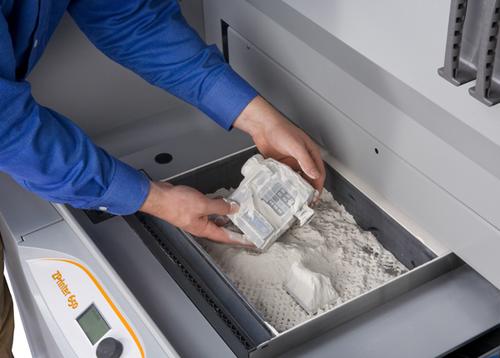
Posted on 05/22/2019 6:29:07 PM PDT by 2ndDivisionVet
What Is It & How Does It Work?
As the name states, a sand 3D printer uses a working medium of sand-like materials, including actual silica sand, ceramics, or even metal particles. The technology is binder jetting, which uses a binder polymer to bind the particles together into a physical 3D model. This can be used to produce finished products or molds for an alternative material to be poured into.
The history of sand 3D printing begins in the late 1990s with a German company, Generis, and with MIT (Massachusetts Institute of Technology) in the United States. Generis focused on sand 3D printing for metal casting molds while MIT developed and patented the 3DP metal binder jet technology. Their work led to the first commercially-available printers offered in the mid-2000s. Licensing arrangements and the division of Generis lead to today’s two main champions of the technology, VoxelJet and ExOne.
A sand 3D printer shares many of the functional attributes of other 3D printing methods. It uses a layer-by-layer printing process that allows the creation of parts with complex internal and external geometries. These layers are defined by slicing the computer part models into thin sections. The sand particles are bound together by a binder “glue” that solidifies the particles into the 3D shape. The average particle size is 140–200 micrometers.
Sand 3D Printer
What Sets Sand Apart?
(Excerpt) Read more at all3dp.com ...
To melt sand or silica has to be incredibly hot so I don’t know of any nozzle that can handle that kind of heat. If there is just sand glued together I’m not really sure what that can make that is useful because glues tend to be toxic so certainly not glassware or plates Maybe I’m Wrong.

Cute. But you’d have to import everything but the sand.
CC
Reading the article before commenting is always advisable.
S-Max® Industrial Production 3D Printer
Here is a low tech solar powered sand printer:
Markus Kayser - Solar Sinter Project
The killer app for the sand printer is not on Earth though, it is building cheap moon bases.

Actually, I'd love for there to be a big lunar "regolith flattener and dust fuser" vehicle run over sites before human landing, to keep the insidious lunar dust from getting into equipment and lungs.
That would be a fine thing to run remotely from the earth until we're ready with new manned landers.
Reading the article before commenting is always advisable.
...
Yep guilty as charged. So I did read it and it’s kind of what I thought it might be which is molds and dies. I see that being very useful for small concrete forms but certainly not for Footers or Foundation walls for buildings or houses. I see if we’re useful for pouring hot metal into the printed form for specific parts possibly even titanium for zirconium if you’re talking about airplane parts for engines. So yep guilty as charged. It is interesting that EXone is one of the companies I wonder if that company straps is still exist. When 3D printers first came out I fortunately saw the light and bought the top three manufacturers of them and also fortunately saw that they were going to be commoditized at some point before people recognized specialty Printing and I sold all of them. It was probably the best decision I made.
The highest melting silica has a MP around 1600C, which isn't really all that hot. Many metals and most non-silica ceramics will have far higher MP's. Carbon has a MP around 3600C (obviously have to exclude O2).
"If there is just sand glued together I’m not really sure what that can make that is useful because glues tend to be on toxic so certainly not glassware or plates.
Plenty of non-toc adhesives available. One method is to heat the "preform" so adhesives burn or evaporate away, and then hotter so the sand particles "sinter" (only melt at contact points and stick together to maintain shape).
"Maybe I’m Wrong."
Yes.
Disclaimer: Opinions posted on Free Republic are those of the individual posters and do not necessarily represent the opinion of Free Republic or its management. All materials posted herein are protected by copyright law and the exemption for fair use of copyrighted works.